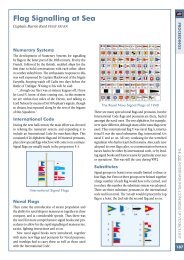The International Brigades in the Spanish War ... - The Flag Institute
The International Brigades in the Spanish War ... - The Flag Institute
The International Brigades in the Spanish War ... - The Flag Institute
Create successful ePaper yourself
Turn your PDF publications into a flip-book with our unique Google optimized e-Paper software.
Luis Sorando gave me a picture that shows Italian comunists<br />
of <strong>the</strong> 5º Regimiento. <strong>The</strong>ir flags are unknown (Fig. 13).<br />
Fig. 13<br />
1.7. German Anarchists<br />
Also Luis Sorando gave me this reproduction of a flag<br />
with <strong>the</strong> three-po<strong>in</strong>ted star of <strong>the</strong> <strong>International</strong> <strong>Brigades</strong><br />
and <strong>the</strong> word “ROTFRONT” over <strong>the</strong> anarchist colours<br />
(Fig. 14). What does it mean? I don’t know.<br />
Fig. 14<br />
2. INTERNATIONAL BRIGADES<br />
On September 21, Maurice Thorez, Secretary General<br />
of <strong>the</strong> French Communist Party, <strong>in</strong>itiated <strong>the</strong> idea of an<br />
<strong>in</strong>ternational force of one brigade of 5,000 volunteers.<br />
After <strong>the</strong> Moscow agreement, <strong>in</strong> September 1936 <strong>the</strong><br />
Comm<strong>in</strong>tern began to recruit people. <strong>The</strong> most important<br />
recruit<strong>in</strong>g centre was Paris. <strong>The</strong> headquarters and<br />
tra<strong>in</strong><strong>in</strong>g centre were placed <strong>in</strong> Albacete, because it was<br />
<strong>the</strong>re that <strong>the</strong> 5º Regimiento (communist militia) had<br />
several facilities.<br />
On October 22, 1936, <strong>the</strong> Government of <strong>the</strong> Republic<br />
approved <strong>the</strong> constitution of <strong>the</strong> <strong>International</strong> <strong>Brigades</strong>.<br />
<strong>The</strong> same day, <strong>the</strong> German battalion “Edgar André”<br />
(also known as Hans Battalion, by <strong>the</strong> name of its first<br />
commander Hans Kahle), <strong>the</strong> French battalion “La Commune<br />
de Paris” and <strong>the</strong> Italian “Garibaldi” made up <strong>the</strong><br />
“9ª Brigada Móvil”.<br />
On November 1, 1936, by decision of <strong>the</strong> President of<br />
<strong>the</strong> Council of M<strong>in</strong>isters, Largo Caballero, <strong>the</strong> “9ª Brigada<br />
Móvil” changed <strong>in</strong>to <strong>the</strong> XI <strong>International</strong> Brigade, under<br />
<strong>the</strong> commandment of general Emile Kleber.<br />
Until September 23, 1938, when Juan Negrín, head of<br />
<strong>the</strong> Republican government, announced at <strong>the</strong> League<br />
of Nations that <strong>the</strong> <strong>International</strong> <strong>Brigades</strong> would be<br />
unilaterally withdrawn from Spa<strong>in</strong>, <strong>the</strong>y were organised<br />
<strong>in</strong> seven brigades:<br />
♦ XI IB, Thaelmann or Hans Beimler<br />
♦ XII IB, Garibaldi<br />
♦ XIII IB, Dombrowski<br />
♦ XIV IB, La Marseillaise<br />
♦ XV IB, L<strong>in</strong>coln<br />
♦ 129 IB, Europa Central<br />
♦ 150 IB, Dombrowski<br />
<strong>The</strong>re was an ephemeral brigade,<br />
♦ XIV bis IB,<br />
and also <strong>the</strong><br />
♦ “86 Brigada Mixta” could be considered “<strong>in</strong>ternational”<br />
from January 1938.<br />
Concern<strong>in</strong>g <strong>the</strong> Brigade flags before October 31, 1937<br />
we do not know if <strong>the</strong>y follow <strong>the</strong> general pattern of<br />
<strong>the</strong> Republic’s Army (Fig. 15). <strong>The</strong>re are several pictures<br />
that show brigade flags as <strong>the</strong> Republic’s colours with<br />
<strong>the</strong> <strong>Brigades</strong> symbol: <strong>the</strong> red three po<strong>in</strong>ted star; was<br />
this a pattern for <strong>International</strong> Brigade flags? Perhaps<br />
(Figs. 16-17).<br />
Fig. 15<br />
Fig. 16<br />
PROCEEDINGS<br />
145






